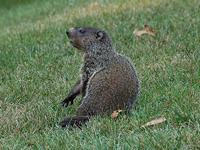Woodchuck/Groundhog
[audio:groundhog.mp3|titles=Groundhogs Sounds]

Peak Nuisance Period: July and August, although their damage may begin in spring and last into the fall.
Common Nuisance Situations:
- Feeding, or just filing down their front teeth, which never stop growing.
- Woodchucks raid gardens, fields, lawns, orchards, nurseries, and may gnaw or claw on shrubs and fruit trees.
- Occasionally chew on outdoor furniture, decks, and siding while scent-marking or filing their teeth.
- Woodchucks may attack humans and pets if confronted
- They are a land engineer. May cause major landscape damage and can create significant structural/foundation problems.
- Marking their territories: They may strip off the bark at the base of a tree that’s near their
- burrow entrance.
- Burrowing. Look for burrow entrances among shrubs near vegetable and ornamental gardens; under woodpiles, brush piles, and stone walls; under sheds, porches, decks, and crawl spaces.
- Burrows in fields may damage agricultural equipment, while those in pastures may trip livestock, resulting in injuries.
- They usually have more than one hole which can extend up to 70 yards.
- Disease risks: Low, mange, rabies (rarely), raccoon roundworm.
Animal Characteristics
Description:
- Woodchucks are grizzled brown on the top part of their coat, some with blackish or rufous tones and they are buffy below.
- Ears are short, rounded and their face has pale puffy patches. Legs are short and powerful and their tail is bushy. They give a shrill whistle, followed by a chuck, chuck.
- Diurnal, most active in the early morning and evening. They rely on dew as their water source.
- Woodchucks have good eyesight, and are good swimmers. They’ll climb trees up to a height of about 20 ft, but most commonly keep it to 8–12 ft. Hibernates deeply from the time of the first heavy frost through early spring. Occasionally hibernates in small groups. Skunks and Woodchucks are known to populate holes together. They do not migrate.
Diet: They are herbivore. Woodchucks eat succulent grasses, weeds, clover, fruits (apples, cherries, pears), berries, field and garden crops (cabbage, lettuce, beans, peas, carrots, alfalfa, soybeans), and ornamental plants (they love phlox). They’ll climb trees to take fruits such as cherries, apples, and pears.
Habitat: Meadows, woodlots, hay fields, pastures, hedgerows, idle fields, parks, suburbs. Dens usually found in open fields; near fence rows or woodland edges; under barns, sheds, porches, decks, stone walls, and wood piles.
Breeding: Breeding period is from February through March. Gestation is approximately 31 days. Birthing typically occurs from late March to Early May. Typical litter is 3 to 4 young.
Mythbusters: N/A
